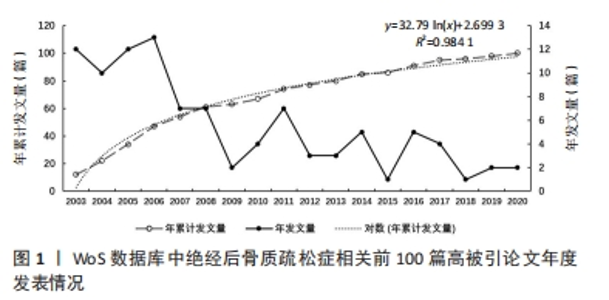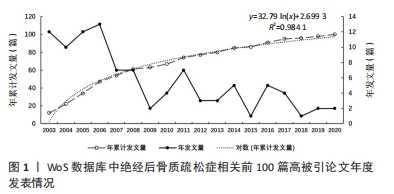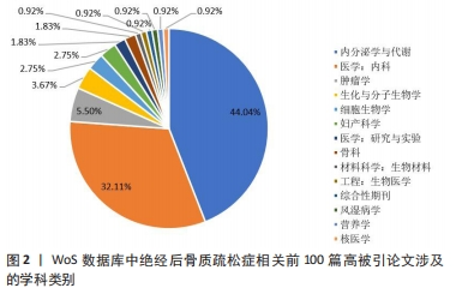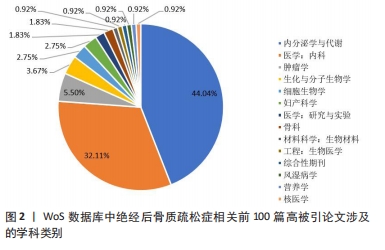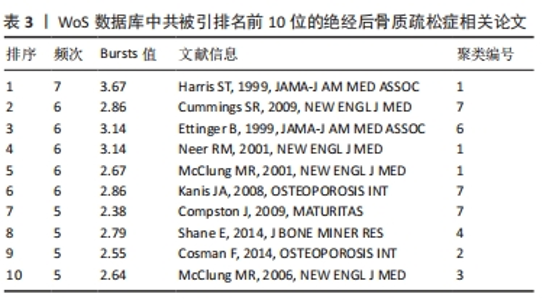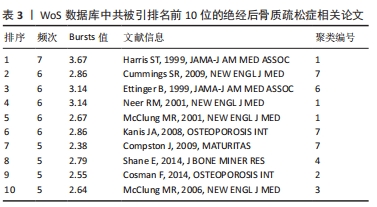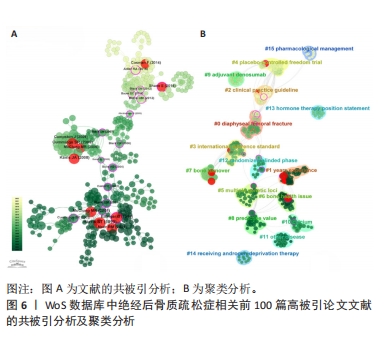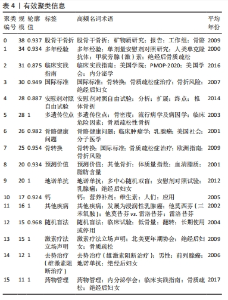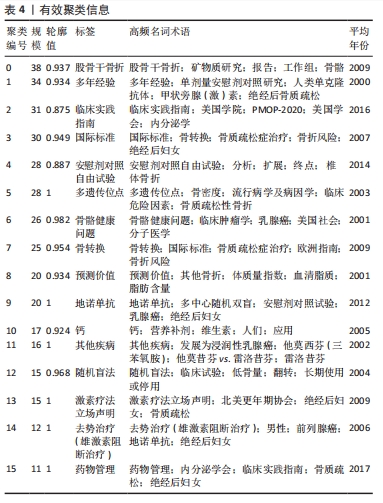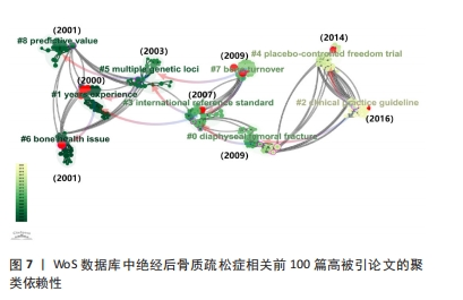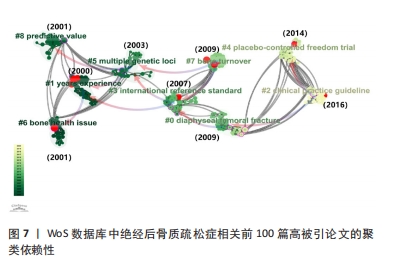Chinese Journal of Tissue Engineering Research ›› 2024, Vol. 28 ›› Issue (35): 5681-5687.doi: 10.12307/2024.803
Previous Articles Next Articles
Bibliometric and visual analysis of postmenopausal osteoporosis based on highly cited SCI papers
Li Yan1, Liu Ning1, Wang Xiaoyang1, Xiao Xiangyu1, 2, Liu Ping1, 3, Zhang Yili4, Jiang Hongjiang5, Zhu Liguo1, Wei Xu1
- 1Wangjing Hospital of China Academy of Chinese Medical Sciences, Beijing 100102, China; 2Shandong University of Traditional Chinese Medicine, Jinan 250013, Shandong Province, China; 3Beijing University of Chinese Medicine, Beijing 100029, China; 4College of Integrated Traditional Chinese and Western Medicine, Nanjing University of Chinese Medicine, Nanjing 210023, Jiangsu Province, China; 5Wendeng Orthopedic Hospital of Shandong Province, Weihai 264400, Shandong Province, China
-
Received:2023-11-18Accepted:2023-12-14Online:2024-12-18Published:2024-03-15 -
Contact:Wei Xu, MD, Researcher, Professor, Doctoral supervisor, Wangjing Hospital of China Academy of Chinese Medical Sciences, Beijing 100102, China -
About author:Li Yan, MD candidate, Wangjing Hospital of China Academy of Chinese Medical Sciences, Beijing 100102, China -
Supported by:National Natural Science Foundation of China (General Progrm), Nos. 82374497 and 82174416 (both to WX); Capital Clinical Characteristic Diagnosis and Treatment Technology Research and Translational Application Project of Beijing Scientific and Technological Program, No. Z221100007422074 (to WX); Jiangsu Provincial Science and Technology Project (Basic Research Program Natural Science Foundation), No. BK20220468 (to ZYL); Shandong Traditional Chinese Medicine Science and Technology Programs, Nos. 2019-0798(to JHJ) and Q-2022030 (to LY)
CLC Number:
Cite this article
Li Yan, Liu Ning, Wang Xiaoyang, Xiao Xiangyu, Liu Ping, Zhang Yili, Jiang Hongjiang, Zhu Liguo, Wei Xu. Bibliometric and visual analysis of postmenopausal osteoporosis based on highly cited SCI papers[J]. Chinese Journal of Tissue Engineering Research, 2024, 28(35): 5681-5687.
share this article
Add to citation manager EndNote|Reference Manager|ProCite|BibTeX|RefWorks

前100篇论文在WoS核心合集中共被引67 377次,平均每项被引674次(344-777次),每篇论文的年平均引用量为49.17次(16.9-189.8次)。被引频次超过1 000次的论文有13篇,排名前5位的论文,见表1。相关性分析显示,论文总被引次数与年平均被引次数之间存在极强的正相关关系(rs=0.655,P < 0.001);论文总被引次数与论文发表时间不存在显著的相关关系(rs=0.122,P=0.226)。前100篇高被引论文涉及医学、工程技术、生物学及综合性期刊4个大类学科和14个小类学科。前3位小类学科依次为内分泌学与代谢(n=48)、医学:内科(n=35)、肿瘤学(n=6),见图2。"

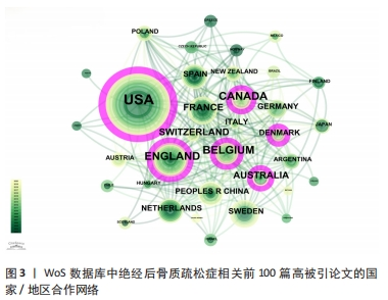
2.2 来源期刊分析 前100篇论文分别刊载在32种期刊上,除《ARTHRITIS AND RHEUMATISM》《ARCHIVES OF INTERNAL MEDICINE》期刊外,其余30种期刊均被收录于2022年JCR期刊目录中。按中科院SCI期刊分区,1区期刊有20种,2区期刊有6种,3区期刊有2种,4区期刊有2种。30种期刊2022年影响因子(impact factor,IF)在2.7-168.9之间。IF≤5.0的期刊有8种,5.0 < IF≤10.0的期刊有6种,10.0 < IF≤50.0的期刊有8种,IF > 50的期刊有8种,IF值前3位期刊依次为《LANCET》,IF=168.9、《NEW ENGLAND JOURNAL OF MEDICINE》,IF=158.5、《JAMA- JOURNAL OF THE AMERICAN MEDICAL ASSOCIATION》,IF=120.7;刊载论文数量排名前3位的期刊分别为《NEW ENGLAND JOURNAL OF MEDICINE》(n=22)、《JOURNAL OF BONE AND MINERAL RESEARCH》(n=21)、《JOURNAL OF CLINICAL ENDOCRINOLOGY & METABOLISM》(n=9),合计刊载论文数量占总量的52%。 2.3 国家/地区合作网络分析 前100篇论文中署名作者共来自35个国家/地区。不同国家/地区之间存在广泛的合作关系,见图3。发文量前5位的国家依次为美国(n=80)、英国(n=33)、比利时(n=22)、加拿大(n=21)、法国(n=19)。5个国家的中介中心度大于0.1,分别为美国(0.25)、英国(0.19)、比利时(0.12)、加拿大(0.11)、丹麦(0.11)。"

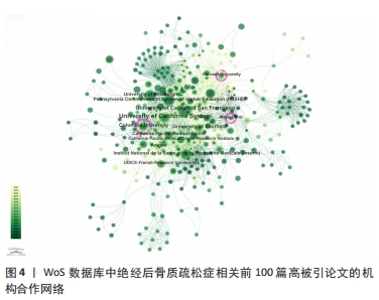
2.4 机构合作网络分析 机构合作网络中获得383个节点,2 215条连线,构成的网络密度为0.030 3。机构间合作关系紧密,见图4。论文发表量前5位的机构依次为加利福尼亚大学系统(University of California System)35篇、加利福尼亚大学旧金山分校(University of California San Francisco)22篇、哥伦比亚大学(Columbia University)17篇、法国国家健康与医学研究所[Institut National de la Sante et de la Recherche Medicale(Inserm)]14篇、安进公司(Amgen)和加利福尼亚太平洋医疗中心(California Pacific Medical Center)均为13篇。8个机构的中介中心度大于0.1,依次为哥伦比亚大学(Columbia University)0.34、俄勒冈州骨质疏松中心0.31、梅奥医学中心(Mayo Clinic)0.2、安进公司(Amgen)0.18、耶路撒冷希伯来大学0.16、临床与基础科研中心(Center Clinical & Basic Research)0.15、法国研究型大学协会(UDICE-French Research Universities)0.14、哈佛大学(Harvard University)0.11。"

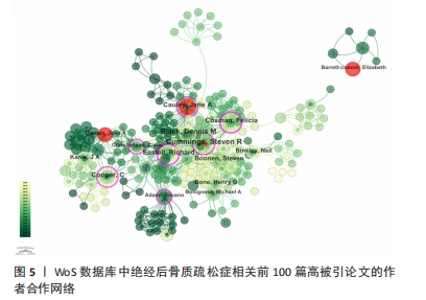
2.5 作者合作网络分析 前100篇高被引论文中包含了341位作者,对应节点之间存在1 180条连线,构成的网络密度为0.020 4,作者合作网络联系紧密,主体网络较为集中,见图5。发文量最高的是Cummings,Steven R 9篇;Black,Dennis M 8篇,位列第2;Cauley,Jane A、Cooper,C、Cosman,Felicia和Eastell,Richard各自以7篇文章数量并列第3。7位学者中介中心性数值大于0.1,分别为Cosman,Felicia(0.25,7篇)、Eastell,Richard(0.21,7篇)、Cummings,Steven R(0.16,9篇)、Christiansen,Claus(0.16,4篇)、Cooper,C(0.14,7篇)、Cauley,Jane A(0.12,7篇)、Adami,Silvano(0.11,4篇)。上述高影响力作者的国家、机构及研究方向信息见表2。"
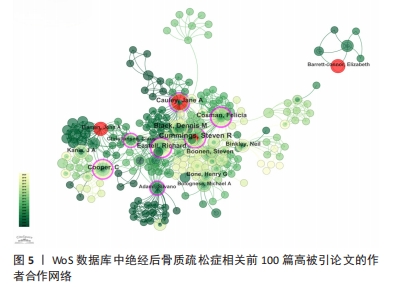
| [1] 中华医学会骨质疏松和骨矿盐疾病分会.原发性骨质疏松症诊疗指南(2022)[J].中华骨质疏松和骨矿盐疾病杂志,2022,15(6):573-611. [2] 魏戌,刘宁,章轶立,等.骨质疏松症的共病研究与早期筛查[J].中国全科医学,2022,25(35):4369-4374. [3] 肖姚,刘颖,吴惠一,等.绝经后骨质疏松症临床实践指南和专家共识的质量评价[J].现代预防医学,2023,50(8):1516-1523. [4] AYERS C, KANSAGARA D, LAZUR B, et al. Effectiveness and Safety of Treatments to Prevent Fractures in People With Low Bone Mass or Primary Osteoporosis: A Living Systematic Review and Network Meta-analysis for the American College of Physicians. Ann Intern Med. 2023;176(2):182-195. [5] 李杰,陈超美. CiteSpace:科技文本挖掘及可视化[M].北京:首都经济贸易大学出版社,2017. [6] SYNNESTVEDT MB, CHEN C, HOLMES JH. CiteSpace II: visualization and knowledge discovery in bibliographic databases. AMIA Annu Symp Proc. 2005;2005:724-728. [7] 李绍烁,顾一丹,邵阳,等.CiteSpace知识图谱可视化分析中医药防治绝经后骨质疏松症[J].中国组织工程研究,2020,24(26):4224-4230. [8] QIU Y, YANG W, WANG Q, et al. Osteoporosis in postmenopausal women in this decade: a bibliometric assessment of current research and future hotspots. Arch Osteoporos. 2018;13(1):121. [9] ZHOU S, TAO Z, ZHU Y, et al. Mapping theme trends and recognizing hot spots in postmenopausal osteoporosis research: a bibliometric analysis. PeerJ. 2019;7:e8145. [10] ZILELI M, FORNARI M, COSTA F, et al. Epidemiology, natural course, and preventive measures of osteoporotic vertebral fractures: WFNS Spine Committee Recommendations. J Neurosurg Sci. 2022;66(4):282-290. [11] JACKSON RD, LACROIX AZ, GASS M, et al. Calcium plus vitamin D supplementation and the risk of fractures. N Engl J Med. 2006;354(7): 669-683. [12] LIU C, KUANG X, LI K, et al. Effects of combined calcium and vitamin D supplementation on osteoporosis in postmenopausal women: a systematic review and meta-analysis of randomized controlled trials. Food Funct. 2020;11(12):10817-10827. [13] HEIDARI B, HAJIAN-TILAKI K, BABAEI M. Effectiveness and safety of routine calcium supplementation in postmenopausal women. A narrative review. Diabetes Metab Syndr. 2020;14(4):435-442. [14] CUI Y, CAI H, GAO Y, et al. Associations of dietary intakes of calcium, magnesium and soy isoflavones with osteoporotic fracture risk in postmenopausal women: a prospective study. J Nutr Sci. 2022;11:e62. [15] LONG G, LIU C, LIANG T, et al. Predictors of osteoporotic fracture in postmenopausal women: a meta-analysis. J Orthop Surg Res. 2023;18(1):574. [16] REIS AR, SANTOS RKF, DOS SANTOS CB, et al. Supplementation of vitamin D isolated or calcium-associated with bone remodeling and fracture risk in postmenopausal women without osteoporosis: A systematic review of randomized clinical trials. Nutrition. 2023;116:112151. [17] CHEVALLEY T, BRANDI ML, CASHMAN KD, et al. Role of vitamin D supplementation in the management of musculoskeletal diseases: update from an European Society of Clinical and Economical Aspects of Osteoporosis, Osteoarthritis and Musculoskeletal Diseases (ESCEO) working group. Aging Clin Exp Res. 2022;34(11):2603-2623. [18] BONE HG, HOSKING D, DEVOGELAER JP, et al. Ten years’ experience with alendronate for osteoporosis in postmenopausal women. N Engl J Med. 2004;350(12):1189-1199. [19] BLACK DM, GREENSPAN SL, ENSRUD KE, et al. The effects of parathyroid hormone and alendronate alone or in combination in postmenopausal osteoporosis. N Engl J Med. 2003;349(13):1207-1215. [20] LEBOFF MS, GREENSPAN SL, INSOGNA KL, et al. The clinician’s guide to prevention and treatment of osteoporosis. Osteoporos Int. 2022;33(10): 2049-2102. [21] SHANE E, BURR D, EBELING PR, et al. Atypical subtrochanteric and diaphyseal femoral fractures: report of a task force of the American Society for Bone and Mineral Research. J Bone Miner Res. 2010;25(11): 2267-2294. [22] SHANE E, BURR D, ABRAHAMSEN B, et al. Atypical subtrochanteric and diaphyseal femoral fractures: second report of a task force of the American Society for Bone and Mineral Research. J Bone Miner Res. 2014;29(1):1-23. [23] LO JC, GRIMSRUD CD, OTT SM, et al. Atypical femur fracture incidence in women increases with duration of bisphosphonate exposure. Osteoporos Int. 2019;30(12):2515-2520. [24] BLACK DM, GEIGER EJ, EASTELL R, et al. Atypical Femur Fracture Risk versus Fragility Fracture Prevention with Bisphosphonates. N Engl J Med. 2020;383(8):743-753. [25] MILLER PD, BOLOGNESE MA, LEWIECKI EM, et al. Effect of denosumab on bone density and turnover in postmenopausal women with low bone mass after long-term continued, discontinued, and restarting of therapy: a randomized blinded phase 2 clinical trial. Bone. 2008;43(2):222-229. [26] CUMMINGS SR, FERRARI S, EASTELL R, et al. Vertebral Fractures After Discontinuation of Denosumab: A Post Hoc Analysis of the Randomized Placebo-Controlled FREEDOM Trial and Its Extension. J Bone Miner Res. 2018;33(2):190-198. [27] 李梅,章振林,夏维波.骨质疏松症药物治疗的必由之路:长程序贯治疗[J].中华骨质疏松和骨矿盐疾病杂志,2021,14(5):441-446. [28] EASTELL R, NICKELSEN T, MARIN F, et al. Sequential treatment of severe postmenopausal osteoporosis after teriparatide: final results of the randomized, controlled European Study of Forsteo (EUROFORS). J Bone Miner Res. 2009;24(4):726-736. [29] KOBAYAKAWA T, MIYAZAKI A, TAKAHASHI J, et al. Verification of efficacy and safety of ibandronate or denosumab for postmenopausal osteoporosis after 12-month treatment with romosozumab as sequential therapy: The prospective VICTOR study. Bone. 2022;162:116480. [30] RAMCHAND SK, LEDER BZ. Sequential Therapy for the Long-Term Treatment of Postmenopausal Osteoporosis. J Clin Endocrinol Metab. 2023:dgad496. [31] JOHNELL O, KANIS JA, ODEN A, et al. Predictive value of BMD for hip and other fractures. J Bone Miner Res. 2005;20(7):1185-1194. [32] COMPSTON JE, WYMAN A, FITZGERALD G, et al. Increase in Fracture Risk Following Unintentional Weight Loss in Postmenopausal Women: The Global Longitudinal Study of Osteoporosis in Women. J Bone Miner Res. 2016;31(7):1466-1472. [33] COMPSTON JE, WATTS NB, CHAPURLAT R, et al. Obesity is not protective against fracture in postmenopausal women: GLOW. Am J Med. 2011; 124(11):1043-1050. [34] LITWIC AE, WESTBURY LD, WARD K, et al. Adiposity and bone microarchitecture in the GLOW study. Osteoporos Int. 2021;32(4):689-698. [35] LI G, COMPSTON JE, LESLIE WD, et al. Relationship Between Obesity and Risk of Major Osteoporotic Fracture in Postmenopausal Women: Taking Frailty Into Consideration. J Bone Miner Res. 2020;35(12):2355-2362. [36] BARRON RL, OSTER G, GRAUER A, et al. Determinants of imminent fracture risk in postmenopausal women with osteoporosis. Osteoporos Int. 2020;31(11):2103-2111. [37] 张晓敏,刘师伟,董进,等.生殖因素对绝经后骨质疏松性椎体压缩性骨折的影响[J].中华骨质疏松和骨矿盐疾病杂志,2023,16(3):236-242. [38] 林靖,阿斯楞,冬梅.内蒙古地区绝经后女性骨密度、骨骼肌与骨折风险性的关系[J].中国组织工程研究,2022,26(14):2133-2137. [39] WANG X, ZHANG Y, QI B, et al. IL-6 and Leptin Are Potential Biomarkers for Osteoporotic Fracture Risk Assessment and Prediction of Postmenopausal Women with Low Bone Mass: A Follow-Up Study Using a Regional Sample Cohort. Oxid Med Cell Longev. 2022;2022:8691830. [40] BLIUC D, NGUYEN ND, NGUYEN TV, et al. Compound risk of high mortality following osteoporotic fracture and refracture in elderly women and men. J Bone Miner Res. 2013;28(11):2317-2324. [41] TAKAHASHI S, TERAI H, HOSHINO M, et al. Risk factors of the poor long-term prognosis of osteoporotic vertebral fractures: A multicenter cohort study. J Orthop Surg (Hong Kong). 2021;29(1):2309499021994969. [42] MORIN SN, YAN L, LIX LM, et al. Long-term risk of subsequent major osteoporotic fracture and hip fracture in men and women: a population-based observational study with a 25-year follow-up. Osteoporos Int. 2021; 32(12):2525-2532. [43] 中国康复医学会骨质疏松预防与康复专业委员会.骨质疏松性椎体压缩骨折诊治专家共识(2021版)[J].中华医学杂志,2021,101(41): 3371-3379. [44] MINAMIDE A, MAEDA T, YAMADA H, et al. Early versus delayed kyphoplasty for thoracolumbar osteoporotic vertebral fractures: The effect of timing on clinical and radiographic outcomes and subsequent compression fractures. Clin Neurol Neurosurg. 2018;173:176-181. [45] INOSE H, KATO T, SHIRASAWA S, et al. Time Course of Acute Vertebral Fractures: A Prospective Multicenter Cohort Study. J Clin Med. 2021;10(24): 5961. [46] MASALA S, MAMMUCARI M, ANGELOPOULOS G, et al. Percutaneous vertebroplasty in the management of vertebral osteoporotic fractures. Short-term, mid-term and long-term follow-up of 285 patients. Skeletal Radiol. 2009;38(9):863-869. [47] ANSELMETTI GC, MANCA A, HIRSCH J, et al. Percutaneous vertebroplasty in osteoporotic patients: an institutional experience of 1,634 patients with long-term follow-up. J Vasc Interv Radiol. 2011;22(12):1714-1720. [48] JOYCE DM, GRANVILLE M, BERTI A, et al. Vertebral Augmentation Compared to Conservative Treatment of Vertebra Plana and High-Degree Osteoporotic Vertebral Fractures: A Review of 110 Fractures in 100 Patients. Cureus. 2022;14(2):e22006. [49] KUO YR, CHENG TA, CHOU PH, et al. Healing of Vertebral Compression Fractures in the Elderly after Percutaneous Vertebroplasty-An Analysis of New Bone Formation and Sagittal Alignment in a 3-Year Follow-Up. J Clin Med. 2022;11(3):708. [50] LI Q, LONG X, WANG Y, et al. Clinical observation of two bone cement distribution modes after percutaneous vertebroplasty for osteoporotic vertebral compression fractures. BMC Musculoskelet Disord. 2021;22(1): 577. [51] TAN L, WEN B, GUO Z, et al. The effect of bone cement distribution on the outcome of percutaneous Vertebroplasty: a case cohort study. BMC Musculoskelet Disord. 2020;21(1):541. [52] SAHINTURK F, SONMEZ E, AYHAN S, et al. The Influence of Percutaneous Vertebral Augmentation Techniques on Recompression in Patients with Osteoporotic Vertebral Compression Fractures. Percutaneous Vertebroplasty versus Balloon Kyphoplasty. World Neurosurg. 2023;176:e447-e455. [53] 杨策凯,蔡卓延,陈明,等.绝经后女性椎旁肌退化与经皮穿刺椎体成形后再骨折的相关性[J].中国组织工程研究,2024,28(9):1414-1419. [54] JIN J, SHEN W. Long-term therapeutic effect of percutaneous kyphoplasty combined with & without back muscle rehabilitation exercise in elderly patients. A comparative study. Pak J Med Sci. 2022;38(6):1595-1600. [55] HUNTOON EA, SCHMIDT CK, SINAKI M. Significantly fewer refractures after vertebroplasty in patients who engage in back-extensor-strengthening exercises. Mayo Clin Proc. 2008;83(1):54-57. [56] STYRKARSDOTTIR U, HALLDORSSON BV, GRETARSDOTTIR S, et al. Multiple genetic loci for bone mineral density and fractures. N Engl J Med. 2008; 358(22):2355-2365. [57] BUCH-LARSEN K, JØRGENSEN NR, JENSEN LT, et al. Denosumab vs. zoledronic acid treatment in post-menopausal breast cancer: a 2-year prospective observational study. Scand J Clin Lab Invest. 2021;81(6):425-431. [58] ROATO I, PAVONE L, PEDRAZA R, et al. Denosumab and Zoledronic Acid Differently Affect Circulating Immune Subsets: A Possible Role in the Onset of MRONJ. Cells. 2023;12(20):2430. |
| [1] | Yang Cekai, Cai Zhuoyan, Chen Ming, Liu Hao, Weng Rui, Cui Jianchao, Zhang Shuncong, Yao Zhensong. Relationship between degeneration of paraspinal muscle and refractures in postmenopausal women treated by percutaneous vertebroplasty [J]. Chinese Journal of Tissue Engineering Research, 2024, 28(9): 1414-1419. |
| [2] | Tong Yibo, Li Minghui. Influencing factors of adjacent vertebral re-fracture in patients with osteoporotic vertebral fractures after percutaneous vertebroplasty [J]. Chinese Journal of Tissue Engineering Research, 2024, 28(8): 1241-1246. |
| [3] | Xu Canli, He Wenxing, Wang Lei, Wu Fangting, Wang Jiahui, Duan Xuelin, Zhao Tiejian, Zhao Bin, Zheng Yang. Bibliometric analysis of researches on liver organoids [J]. Chinese Journal of Tissue Engineering Research, 2024, 28(7): 1099-1104. |
| [4] | Sun Yukang, Song Lijuan, Wen Chunli, Ding Zhibin, Tian Hao, Ma Dong, Ma Cungen, Zhai Xiaoyan. Visualization analysis of stem cell therapy for myocardial infarction based on Web of Science in recent ten years [J]. Chinese Journal of Tissue Engineering Research, 2024, 28(7): 1143-1148. |
| [5] | Shang Peng, Cui Lunxu, Ma Benyuan, Hou Guanghui, Song Wanzhen, Liu Yancheng. Effect of restored height on neighboring vertebrae after vertebral body strengthening: a finite element analysis [J]. Chinese Journal of Tissue Engineering Research, 2024, 28(36): 5741-5746. |
| [6] | Wang Xiaopeng, Zhong Rong, Zhong Yan, Lin Feng, Ye Shuxi. Influencing factors of adjacent vertebral refracture in elderly female patients with osteoporotic vertebral compression fracture and construction of a prediction model based on Nomogram [J]. Chinese Journal of Tissue Engineering Research, 2024, 28(36): 5799-5804. |
| [7] | Luo Weidong, Zou Lihua, Huang Da. Visual analysis of hot topics in concussion field by finite element method: Improvements in brain injury models, test methods and protective devices [J]. Chinese Journal of Tissue Engineering Research, 2024, 28(34): 5487-5493. |
| [8] | Yuan Yanli, Pan Yuejun, Guan Tianmin, Cheng Kai, Wang Xiangheng. Bibliometric and visual analysis of domestic and foreign scoliosis orthoses [J]. Chinese Journal of Tissue Engineering Research, 2024, 28(33): 5396-5402. |
| [9] | Xu Yi, Deng Yubin. Exoskeleton-assisted walking rehabilitation for spinal cord injury: CiteSpace analysis of research hotspots [J]. Chinese Journal of Tissue Engineering Research, 2024, 28(33): 5403-5412. |
| [10] | Yan Jie, Zhou Jing, Zhao Jingpu, Zhang Qingfang, Zhou Mingchao, Wang Yulong. Visual analysis of high-definition transcranial direct current stimulation research [J]. Chinese Journal of Tissue Engineering Research, 2024, 28(32): 5110-5115. |
| [11] | Yang Rui, Cao Kai, Zhao Wei, Wang Qingbo, Lu Chunmin, Zhang Yan. Mechanisms by which high-intensity interval training influences bone health in a rat model of postmenopausal osteoporosis [J]. Chinese Journal of Tissue Engineering Research, 2024, 28(32): 5141-5147. |
| [12] | Yang Juncong, Huang Rui, Wu Xie. Visualization of the biomechanical characteristics of long-distance running landing patterns [J]. Chinese Journal of Tissue Engineering Research, 2024, 28(32): 5159-5166. |
| [13] | Tao Guangyi, Wang Linzi, Yang Bin, Huang Junqing. Research hotspots of artificial intelligence in the field of spinal deformity: visual analysis [J]. Chinese Journal of Tissue Engineering Research, 2024, 28(30): 4915-4920. |
| [14] | Li Shudong, Liang Xuezhen, Luo Di, Li Jiacheng, Yan Bozhao, Li Gang. Identification of biomarkers associated with ferroptosis and pyroptosis for the potential diagnosis of postmenopausal osteoporosis [J]. Chinese Journal of Tissue Engineering Research, 2024, 28(28): 4511-4515. |
| [15] | Zhang Zhilong, Yang Shengping, Chen Tianxin, Zhu Yuqi. Research hotspots and trends in the field of articular cartilage repair: a visualization analysis [J]. Chinese Journal of Tissue Engineering Research, 2024, 28(27): 4306-4311. |
| Viewed | ||||||
|
Full text |
|
|||||
|
Abstract |
|
|||||
